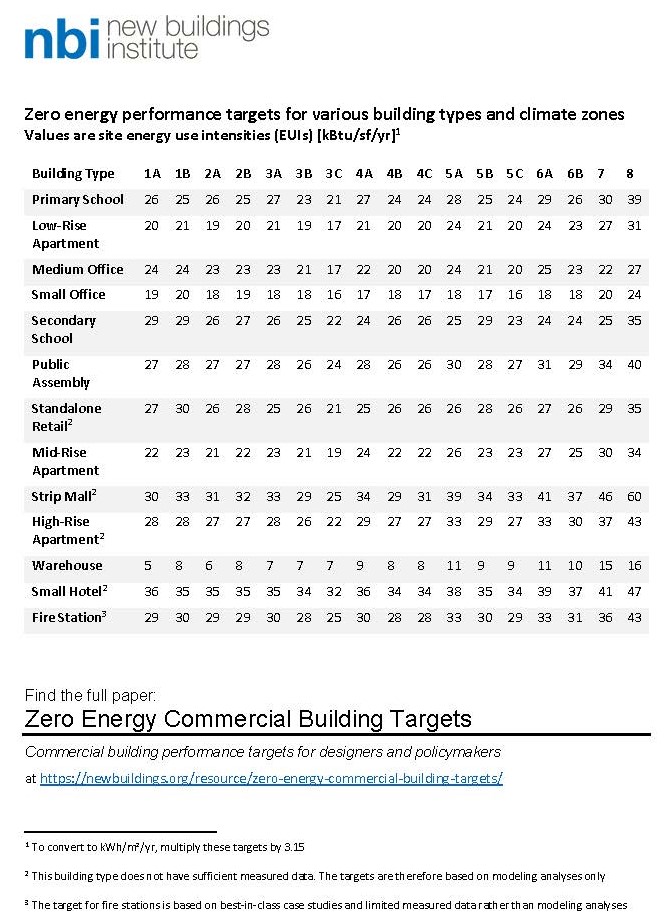When targeting zero energy performance in buildings, the first step is typically setting an energy performance target that the design team can aim for. But, setting that target, typically communicated as the project’s energy use intensity (EUI), is not always easy. To help guide the process, New Buildings Institute (NBI) has released a new paper, Zero Energy Commercial Building Targets, that details energy use intensity (EUI) recommendations for zero energy new construction projects across all U.S. climate zones and for common building types.
Zero energy buildings are ultra-low energy buildings capable of producing all the energy they consume over the course of a year from onsite renewable energy resources. Energy efficiency is one of the most cost-effective ways to address climate change as well as rising energy costs while increasing property value and occupant productivity. Buildings account for 40% of carbon emissions globally, which is why a growing number of jurisdictions, designers and owners are pursuing ambitious energy reduction goals in both individual buildings and across entire portfolios.
At the onset of a project, designers typically set an EUI target for building energy performance and then use energy modeling software to determine how likely their project is to meet that goal. The lower the EUI, the less energy the building is expected to use. Climate and building use/type, along with energy efficiency measures for building envelope, windows, and HVAC systems, determine a building’s energy performance. To help with this work, NBI leveraged data from hundreds of high performance building examples in our Getting to Zero Database in combination with published energy modeling analyses to create ambitious yet attainable EUI recommendations. This information was analyzed and developed to guide the various people working on zero energy buildings with appropriate targets. This will ultimately create a common approach and reduce the time for individual analysis.
How to use these recommendations
NBI’s zero energy performance target recommendations may be used by:
-
- Design teams or building owners to set an initial goal for a new building design.
- Code writers to determine a target end point for zero energy policies.
- Jurisdictions and other organizations that have set a goal to reduce energy use over time and need a way to track progress.
1. Design
NBI’s recommendations allow designers to more quickly answer the question: What EUI should we aim for in order to achieve zero energy for this project? Setting an energy target focuses the design team and gives the owner, architect, engineer, contractor and other team members a common goal for the project. Previously, NBI has been recommending that design teams aim for an EUI between 20-24, with the balance of energy use met by renewable generation. This number is a national average of all buildings in our Getting to Zero Database, and includes many building types and climates.
Given the growing market demand for zero energy buildings across sectors and around the United States, we realized that design teams need information that is more specific. Not every project will reach zero energy at these performance levels with onsite renewables, depending on solar availability, and space for solar photovoltaic panels. In these cases, projects can procure offsite renewable energy.
2. Code
Many jurisdictions attempting to meet aggressive climate action goals are setting zero energy targets for individual buildings and groups of buildings via policy recommendations. NBI has been assisting many of them, including the city of Boulder and the states of Vermont and New York. NBI’s newly released zero energy performance target recommendations will assist and accelerate jurisdictions’ ability to meet climate action goals in a myriad of ways, including performance pathways, outcome-based approaches, incentives and penalties, or other innovative mechanisms. Following are some examples.
Seattle Energy Code
The 2015 Commercial Seattle Energy Code includes an alternative compliance path that sets an energy target for buildings. This target performance path sets an EUI requirement to be met both via modeling and in operation once the building is occupied. The building must perform to the energy target level (annual energy use) within a three-year window after occupancy.
City of Boulder, Colorado
The City of Boulder is plotting a pathway for its energy code to meet zero energy performance by 2030. Each code cycle ramps down an energy target for various building types, ultimately reaching “zero energy ready” performance targets. The city has customized the targets and pathways for each building type.
California Department of General Services
The California Department of General Services has published source energy use intensity targets for existing state buildings pursuing zero net energy. These targets support California’s goals of reaching a 100% clean electric grid by addressing the energy demand from existing buildings.
3. Jurisdictions and Other Organizations
Reaching zero energy performance targets is entirely possible today. Since Architecture 2030 issued The 2030 Challenge in 2006 calling for all new buildings, developments, and major renovations to be carbon-neutral by 2030, more than 525 design firms have signed a 2030 Commitment (a voluntary agreement to work toward carbon neutrality in the built environment). Meeting these goals is not easy but it is possible. As of 2017, 10 U.S. firms had met their target EUIs across their building portfolio and more than 200 reported their status. For those who did not yet meet their goals, each step along the way represents progress and another opportunity find innovative ways to reach deep energy savings.

To learn more about zero energy and zero carbon buildings, join us this October 9-11 at the Getting to Zero Forum in October and check out these additional online resources:
• Getting to Zero Database
• State And Local Government Toolkit
• Full paper on Zero Energy Performance Targets
• Recommended Targets table: Zero energy performance targets for various building types and climate zones
Contact Kevin Carbonnier, NBI project manager, by email with any questions.
